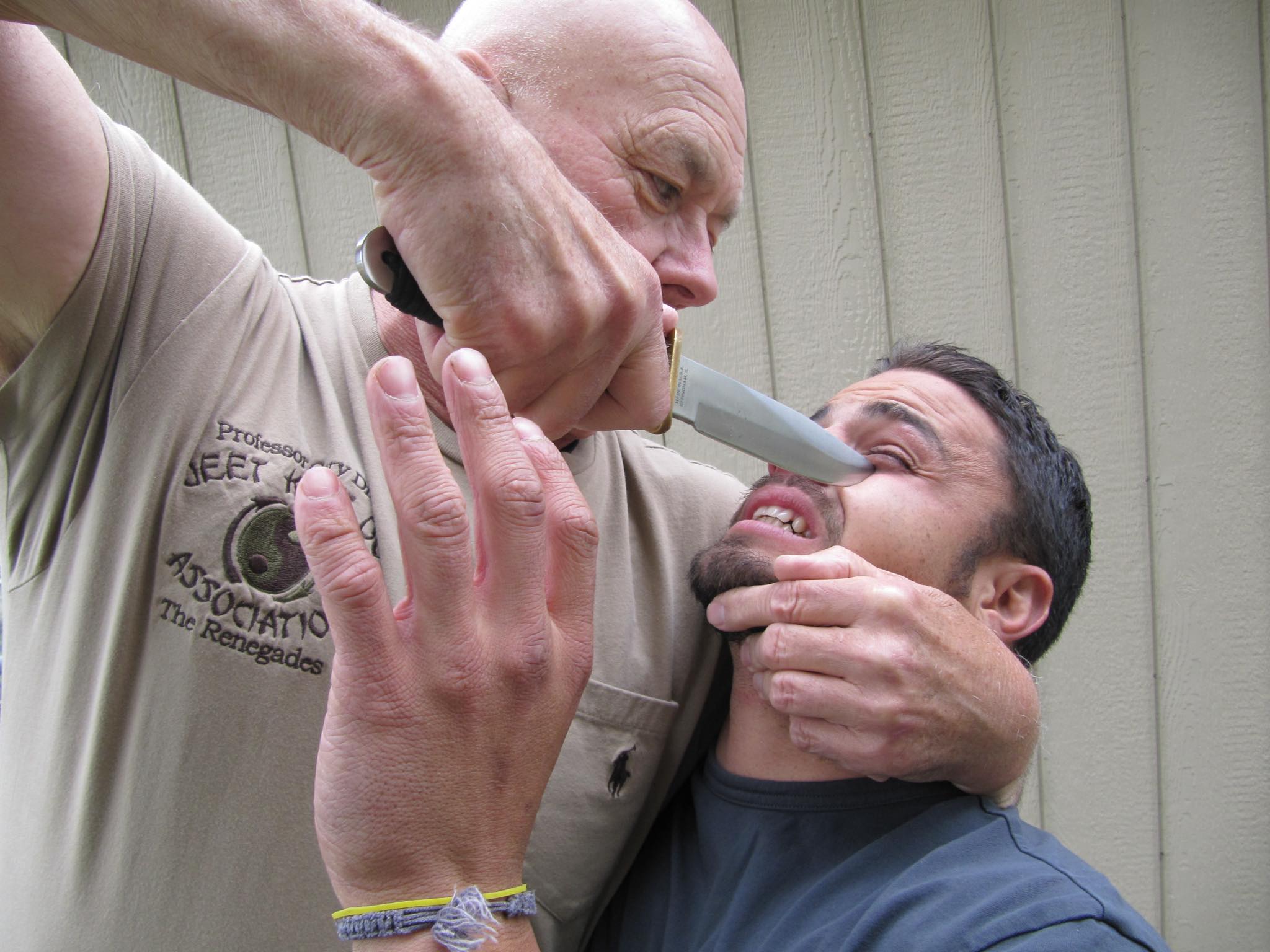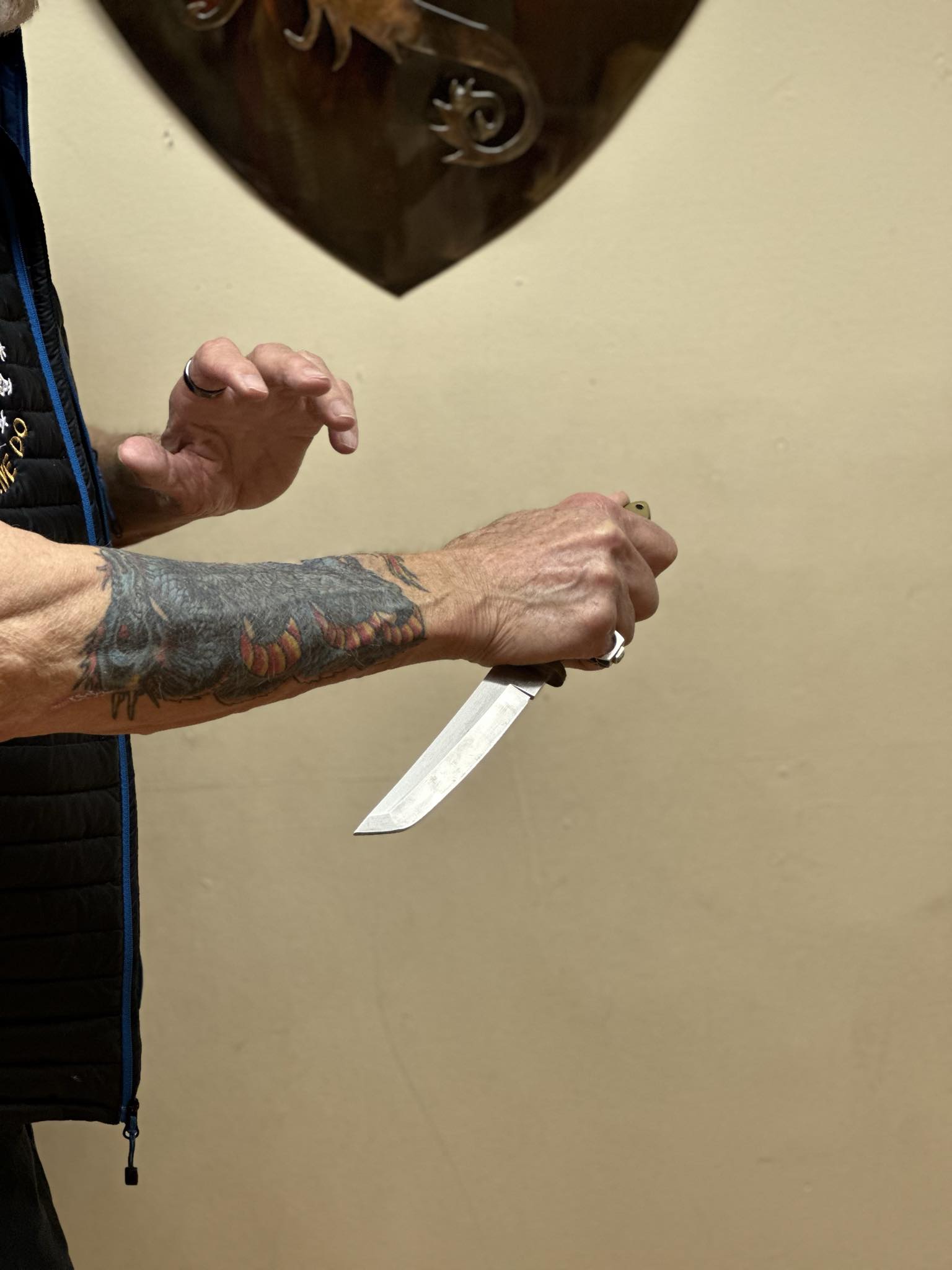
10 minute read
JKD Knife Applications
Professor Gary Dill
The knife has been vital to a warrior’s personal arsenal for thousands of years.
It is nearly as old as mankind. Even with the high-tech weapons used in combat, the knife is still found in the hands of today’s modern military combatant. In close-quarters combat, the blade is as important now as it was during the time of the ancient samurai.
Several years ago, the army announced that it was replacing traditional bayonet training (using the blade on the end of the rifle) with using the bayonet as a knife for CQC applications
The knife has one purpose: to incapacitate or terminate the enemy
For the combatant to be effective in using the knife, he/she must have two major components:
(1) the instinct to survive and the willingness to wound or terminate the enemy, and
(2) a realistic system of using the knife.
After returning from a tour of duty in Vietnam in early 1971, I was accepted in the exclusive Oakland JKD class taught by James Lee with Bruce Lee being the head instructor.
Regarding training with a knife, James told me that, “When you learn JKD, you already know how to use a knife The knife becomes an extension of your hand. You simply do the same empty hand JKD techniques but, with the knife in your hand.”
I then understood the principle of the Oakland JKD knife fighting, which was not related to Filipino Kali, Escrima, or any other knife fighting style, but was a different system of its own, based strictly on Bruce Lee’s original Jeet Kune Do empty hand fighting techniques.
This laid the groundwork for my personal JKD combat knife system that I have been teaching for years. Just weeks after 9/11 I was hired by a military contractor company to develop a CQC empty hand and weapons program. Later a Homeland Security training company contracted me to provide them a CQC program to be taught to their members and clients. Since that time, I have trained many Homeland Security and Special Operation military personnel my system of JKD knife tactics.

As part of my JKD knife combat training, I emphasize developing the mindset of terminating or seriously disabling the enemy James Lee would lecture our small JKD class, stating, “If you want to be a real JKD fighter, you must develop the Killer Instinct.”
Still on active military duty at this time, having just returned from Vietnam, I understood exactly what he meant.
The combatant must be willing and able to take out the enemy without hesitation, without remorse. It is a matter of survival with attitude. You have to work this out in your own mind, your own moral compass, as to what you are willing to do in order to survive.
Waiting until the fight starts to cope with this philosophical issue is too late. If you do, you will be distracted, and you will be dead.
Hesitation kills. You must already resolve it within yourself so that when the moment arises when you are facing your enemy, you will not hesitate to attack and defend yourself. When you attack with your knife, it should be done immediately in the blink of an eye.
You need to reflect the mindset of the Samurai and terminate your opponent without hesitation or compassion. The only thing on your mind should be the elimination of the threat of your enemy. Do not think about what he can do to you, but what you will do to him.
My personal JKD combat knife system demonstrates an arsenal of effective and devastating blade techniques based upon the original Oakland JKD techniques and tactics, along with some “specialized” techniques acquired during my military and intelligence career.
We use only two combat grips, the SABRE GRIP and the REVERSE GRIP.


Let’s make it clear: on the battlefield or on the street, you are not dueling with a knife. There should be no fancy moves like in the movies. You use the knife to terminate or seriously wound the enemy during combat when a firearm is not accessible.
There is no “fairness” in battle; you either win or lose. You fight to survive with whatever means are available. The knife is used as your backup weapon. Or you may be involved on a mission where you must use stealth and silence, and the knife or empty-hand techniques are the only tools you can use.
While in the military and law enforcement, I always carried a backup knife, which was my ace up my sleeve You can dispatch the enemy efficiently and quickly if you are properly trained with a knife. But the keywords here are “properly trained”
You have to know how to grip the knife, how to position your hands, how to utilize the appropriate stance, how to recognize the best and most accessible target, and most importantly, how to execute the most appropriate and efficient knife techniques during your attack.
This is where Jeet Kune Do comes into the picture.
From my own real-life combat experience, I believe that the original JKD is one of the world's most effective combat martial arts today.
JKD is simple, direct, and deceptive. There is no sport, rituals, aesthetics, or competition in JKD. It is reality-based combat. When trained in the original JKD and put a knife in your hand, you now have a deadly and efficient knife-fighting system

DILL’S PRINCIPLES OF JKD KNIFE FIGHTING
Only use a knife when your life is at stake or serious bodily injury. No exceptions
In my system, we use only two grips: Sabre or Reverse. They both have their own dynamics and purposes.
Use a few knife techniques that work best for you. Train with them, get them down to a pure conditioned reflex. Be able to apply them without thinking. Thinking is your enemy in combat; when fighting you must rely on “muscle memory.”
Attack and cut whatever part of his body is closest to you. For example, when the opponent is facing you in a stance, cut his hand closest to you. Hack away and eliminate his ability to block your knife strikes Also, psychological shock will set in and make it easier to stop the enemy’s threat.
Draw first blood and induce psychological shock Most people have not been in actual combat and have not experienced serious bleeding. Upon realizing that they have been cut and are bleeding, when in combat many will go into psychological shock, and realize that their life is now in serious danger.
Psychological shock is the knife fighter’s best tool because it can neutralize the enemy quicker than the actual wound.
Attack with resolve and without hesitation. When in actual combat, practical training and conditioned reflexes must take over. Long before he goes into combat, one must work out any moral issues they may have regarding injuring or taking the life of an enemy.
The battlefield is not the time or place to wrestle with this issue in combat, there is no time for hesitation; you must take action immediately…………before your enemy does.
Maintain forward energy Be aggressive! Real combat is not the place to be passive or defensive. Defensive tactics result in giving your opponent more opportunity to terminate you. To survive combat, you must be aggressive, keep pressing in on your opponent, and do not give him any time to respond or counterattack.
Do not try to intimidate with the knife. The purpose of the knife on the battlefield is to terminate the enemy.
Combat is not the time to “play” with an enemy, or to try to scare him. Just move in accordingly and take him out without hesitation. Real street combat is not like the make-believe movie fighting. You need to finish the knife combat within a few seconds. The longer you fight, the more chances he has to injure or kill you.
Be quick, if you are slow in combat, you probably won’t survive. Regardless of how many knife techniques you may know, if they don’t get to the target, they are worthless Speed is everything as well as learning effective knife tactics, you must also train in executing them quickly
Keep your movements minimal, simple, and direct. Forget what you see in the movies. All of those fancy moves are not functional in real knife combat. Keep your attack simple and direct, no dojo ballerina moves.
The fewer moves you execute in knife combat, the fewer openings you give your opponent, and the fewer opportunities for his counterattack.
Use footwork for evasion and attack. JKD footwork works great for knife applications because of the emphasis on angular movements and the forward lunge with a straight knife thrust. (Bruce Lee incorporated this move from fencing.)
Maintain your centerline when positioning your knife Just as in JKD, the knife combatant needs to protect his vital organs and utilize the closed centerline theory from Wing Chun. As in JKD, lead with your strongest and most coordinated hand, thus the knife should be in the leading hand he knife is there to protect you, not you protecting the knife. If the opponent wants to get to you, he must be able to try to get through your knife, which will end poorly for him.
Be familiar with critical targets on your opponent. Attack to terminate or seriously disable. Attack specific targets such as the throat, side of the neck, solar plexus, groin, the eye, supra sternal notch, subclavian region, base of the skull, and kidn Become very familiar with these t areas.
These knife-fighting principles ca devastating when applied using th JKD techniques and in conjunctio proper mental and psychological preparation

About the Author
Professor Gary Dill has been active in JKD for 53 years and is one of the few original students still living (1971 – Present.) Dill trained in JKD at the Oakland school under James Lee with Bruce Lee being the head instructor. He is the founder and Chief Instructor of the Jeet Kune Do Association (founded in 1991 ) Dill spent many years in the military (Vietnam veteran, Special Agent with NCIS (Office of Naval Intelligence), and was a state criminal investigator working narcotics, homicides, organized crime, and police corruption
While a Special Agent with NCIS, Dill was a close-quarters combat (CQC) and firearms instructor. Also, he was the senior police defensive tactics instructor for the state of Oklahoma police certification agency (CLEET.) He worked as a private military “contractor” and taught CQC and knife tactics to military spec ops and Homeland Security personnel.
Professor Gary Dill is a regular contributor to IMA Magazine. Catch his monthly column and insight in every issue.
He can be contacted at pdilljkd@aol com , and his website is www.jkd-garydill.com .








